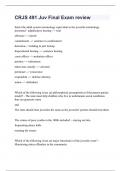Exam (elaborations)
CRJS 491 Juv Final Exam review
- Course
- CRJS
- Institution
- Athabasca University (AU )
Select the adult system terminology equivalent to the juvenile terminology presented - adjudicatory hearing --> trial aftercare --> parole commitment --> sentence to confinement detention--> holding in jail/ lockup dispositional hearing --> sentence hearing court officer --...
[Show more]



